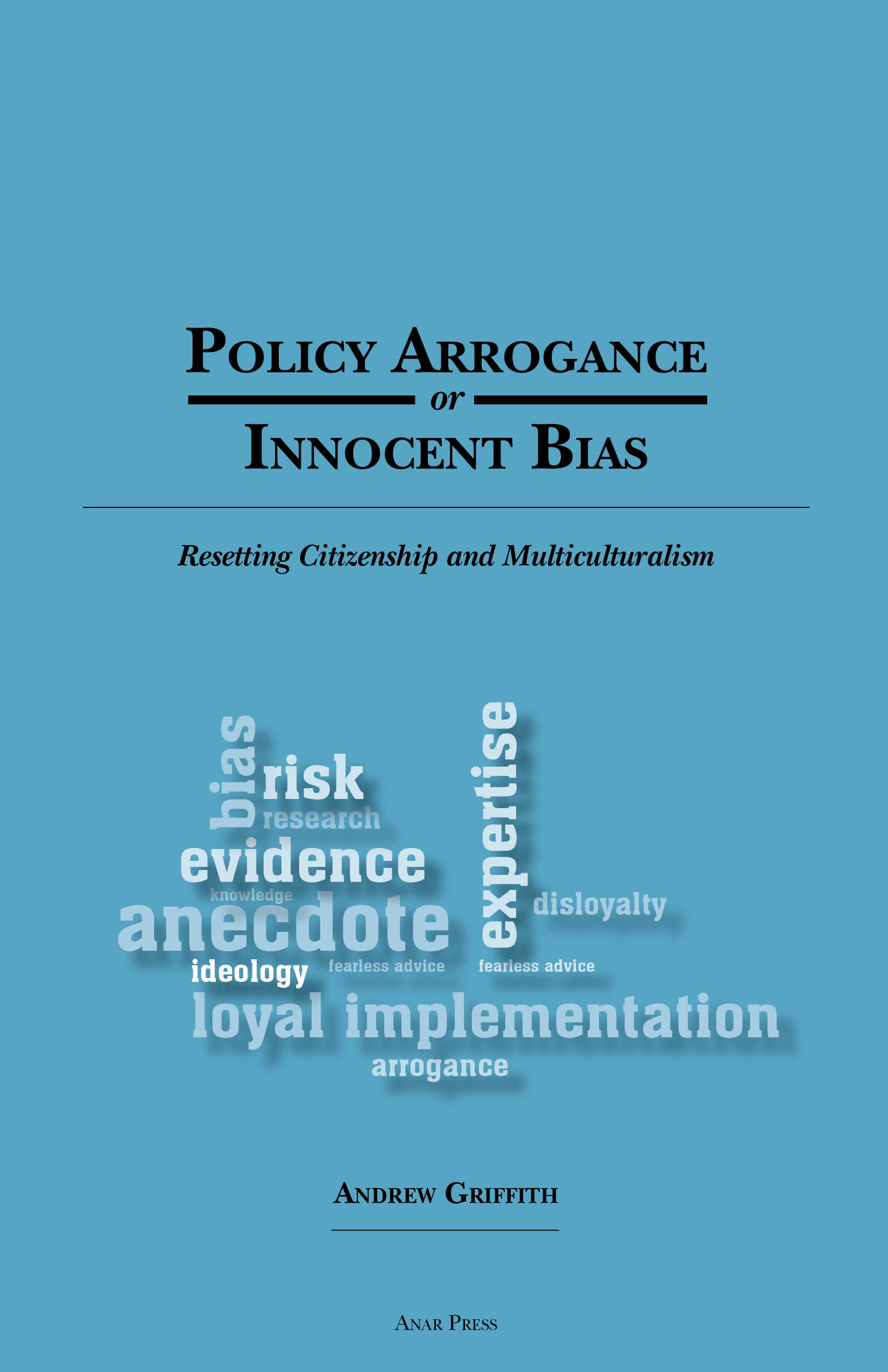BOOK REVIEW: Policy Arrogance or Innocent Bias: Resetting Citizenship and Multiculturalism, by Andrew Griffith, Anar Press, 2013, 117 pages
 Any time a just-retired mandarin decides to write about his days serving the “Harper Government” should be good for the health of Canadian democracy. Our system of government is kept alive in the delicate balance and dance that defines the relationship between an elected government and career bureaucrats, and it comes as no surprise that Andrew Griffith’s insider account of Ottawa is still rife with tension – even nearly eight years after the Conservatives came to power.
Any time a just-retired mandarin decides to write about his days serving the “Harper Government” should be good for the health of Canadian democracy. Our system of government is kept alive in the delicate balance and dance that defines the relationship between an elected government and career bureaucrats, and it comes as no surprise that Andrew Griffith’s insider account of Ottawa is still rife with tension – even nearly eight years after the Conservatives came to power.
Mr. Griffith is generally sympathetic to the Conservatives, or at least to Jason Kenney, who he describes in an interview with New Canadian Media, as “arguably the most effective Minister in the Harper government.” His book, though, is not an outright endorsement of all that Mr. Kenney did at the citizenship and immigration portfolio, but in a broad sense, he sees most of the changes as positive and ultimately helpful to sustaining public support for relatively high levels of immigration.
But, before he got there, the Minister met with stiff resistance.
Policy Arrogance or Innocent Bias is a must-read for anybody in Canada who is part of the vast immigration sector (nay, industry) or is interested in the sausage-making policy apparatus in Ottawa. It offers unique insight into how Ministers relate to the public service, how bureaucrats try their hardest to have their way in dubious “Yes, Minister” style, and the extent of disconnect between these two pillars of democracy in particularly contentious areas such as citizenship-immigration, environment or foreign affairs. This consummate public servant of 30 years must be given credit for calling it like it is: “After all, governments are elected, whereas public servants are not, and governments are ultimately accountable for their decisions before the public.”
He comes down hard on his “know-it-all” former colleagues who often have a hard time acknowledging their own biases and lack of objectivity: “who are sometimes ideologues in disguise.”
Inside baseball
Mr. Griffith cites a series of episodes during Mr. Kenney’s tenure at Citizenship and Immigration Canada (CIC) to illustrate the “circle of arrogance” that characterized meetings between Minister Kenney and his civil service advisors. Each side was entrenched in their opinions, with bureaucrats seeing the new Minister’s ideas as an “existentialist challenge to the role and expertise of the public service.” The author often gives readers a fly-on-the-wall account of how policy evolved in the frying pan of this tension.
One of the more long-term consequences of Mr. Kenney’s tenure at CIC has been the impact that his ears-to-the-ground approach has had on the policy-making apparatus. Bureaucrats who swore by the absolute authority of the evidence they gathered from large-scale surveys and focus groups were forced to recognize the value of “granular detail” provided by anecdotes relayed by the Minister through hundreds of events he personally attended. The author has done a commendable job offering readers a snapshot of the number of outreach events that Mr. Kenney went to and the ethnic communities that seemed to have more of the ear of the Minister. Here’s a nugget: in the author’s reckoning, Minister Kenney delivered 273 speeches and statements to cultural communities between 2007 and 2011.
The Minister invariably had his way in his face-off with mandarins, but before getting there he had to get the civil service to expand their definition of what constituted “evidence”. Could random notes taken at these so-called ‘curry events’ actually form part of evidence going into policy making? Officials initially balked, but eventually had to give in under the sheer weight of information coming in from these informal sounding boards. But, when they did, they did so with remarkable enthusiasm, finally quoting from the Minister’s own speeches to buttress their policy proposals.
Test of citizenship
Another big change during Mr. Kenney’s tenure at CIC was the introduction of a much-tougher citizenship guide called “Discover Canada,” replacing the rather rudimentary “A Look at Canada” that had served as the textbook for newcomers since 1996. The new version was a complete overhaul and included this memorable line that took most Canadians by surprise: “Canada’s openness and generosity do not extend to barbaric (italics introduced for emphasis) cultural practices that tolerate spousal abuse, ‘honour killings,’ female genital mutilation, forced marriage or other gender-based violence.”
Part of the desire to have a new guide was to make it harder for permanent residents to become citizens if they do not have enough grounding in Canadian history and are not fluent in either English or French. The “activist” Minister also picked up anecdotal evidence during his outreach events of widespread cheating, with citizen-applicants able to buy the standardized tests in the illicit market. Pass rates plummeted almost immediately after the new tests were introduced – from 96 per cent to 70 per cent, before they recovered to a more acceptable 80-85 per cent when the questions were slightly modified to make them more comprehensible.
While Mr. Griffith welcomes the more rigorous test, he suggests the new questionnaire would have benefited from focus-group testing. And, as other commentators have pointed out, most Canadians would not do well on the test. The author cites this rather telling factoid in one of his footnotes: “[W]e ran a mock test at a policy sector retreat with several hundred policy analysts, providing a reasonable proxy for most Canadians’ level of citizenship knowledge – most failed.” That should be cold comfort for those newcomers who continue to fail the new tests and are therefore denied citizenship.
Downplaying racism
A more nuanced – but perhaps most significant – revision introduced in the last few years has been the moving away from themes such as “racial discrimination,” “removing barriers” and “employment equity.” In its place has come “radicalization,” “inter-faith dialogues” and a closer look at divisions within and between immigrant communities. Mr. Griffith writes that the issue of mainstream-visible minority relations is no longer an area of interest. This has been replaced by what the Minister referred to as “intolerance and prejudice … experienced between new Canadians who come from the same country or region of origin.”
In short, Mr. Griffith narrates in bookish prose how CIC was remade in the image of the Conservatives – drawing its essence from the erstwhile Reform Party’s preference for integration over multiculturalism and a more muscular citizenship. He pays less attention to immigration and refugee policy, but the changes there have been well reported and were generally seen within the bureaucracy as long overdue, although some independent observers would argue the reforms have gone too far. This summer, though, the citizenship-immigration-multiculturalism portfolio was split between a new Minister for CIC (Chris Alexander), while Mr. Kenney moved to Human Resources and Skills Development Canada, retaining the multiculturalism file – where, the author suspects, it will die a slow death. – With additional reporting by NCM staff
Editor’s note: Mr. Griffith writes a blog under the title Multicultural Meanderings




